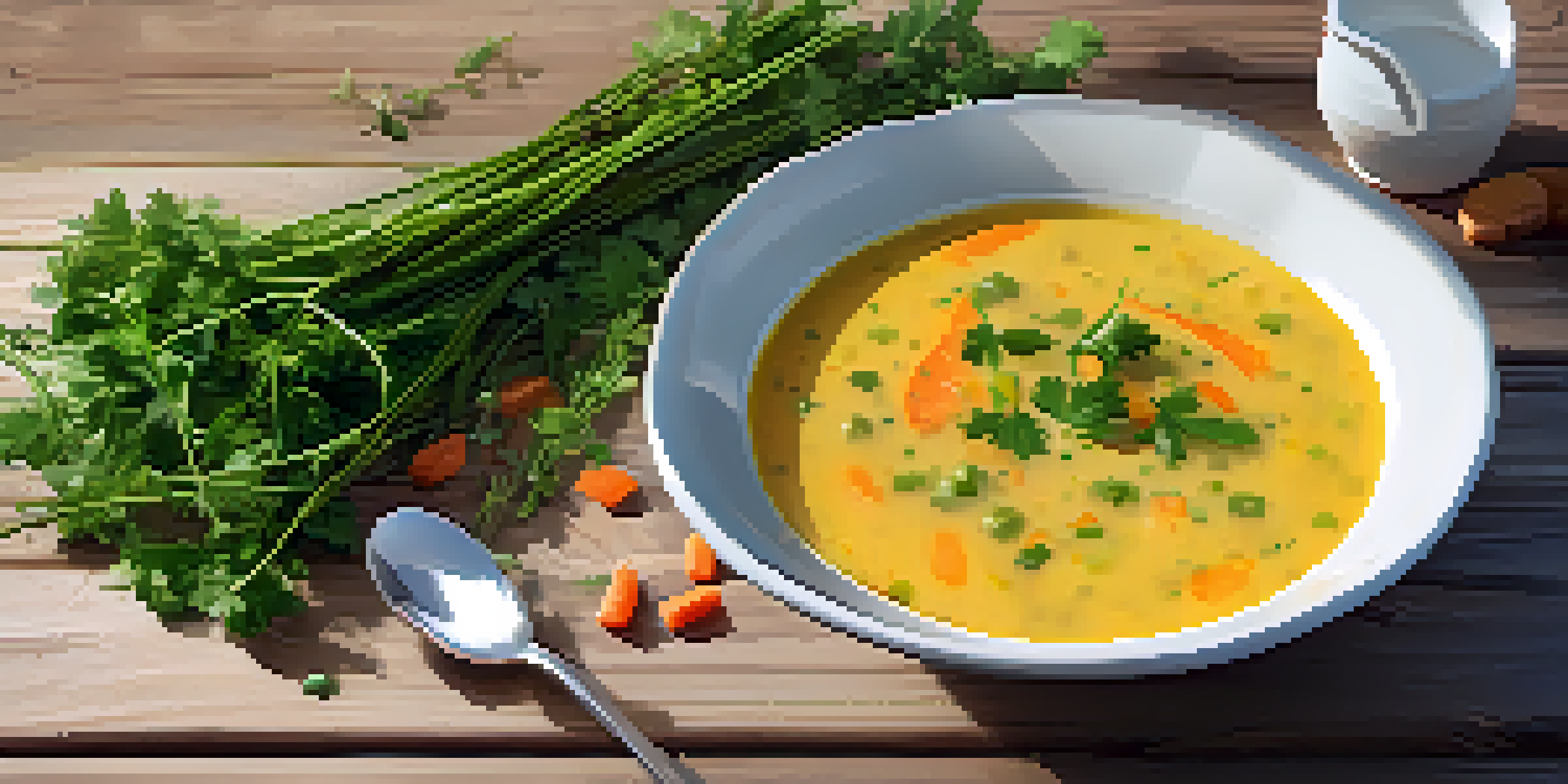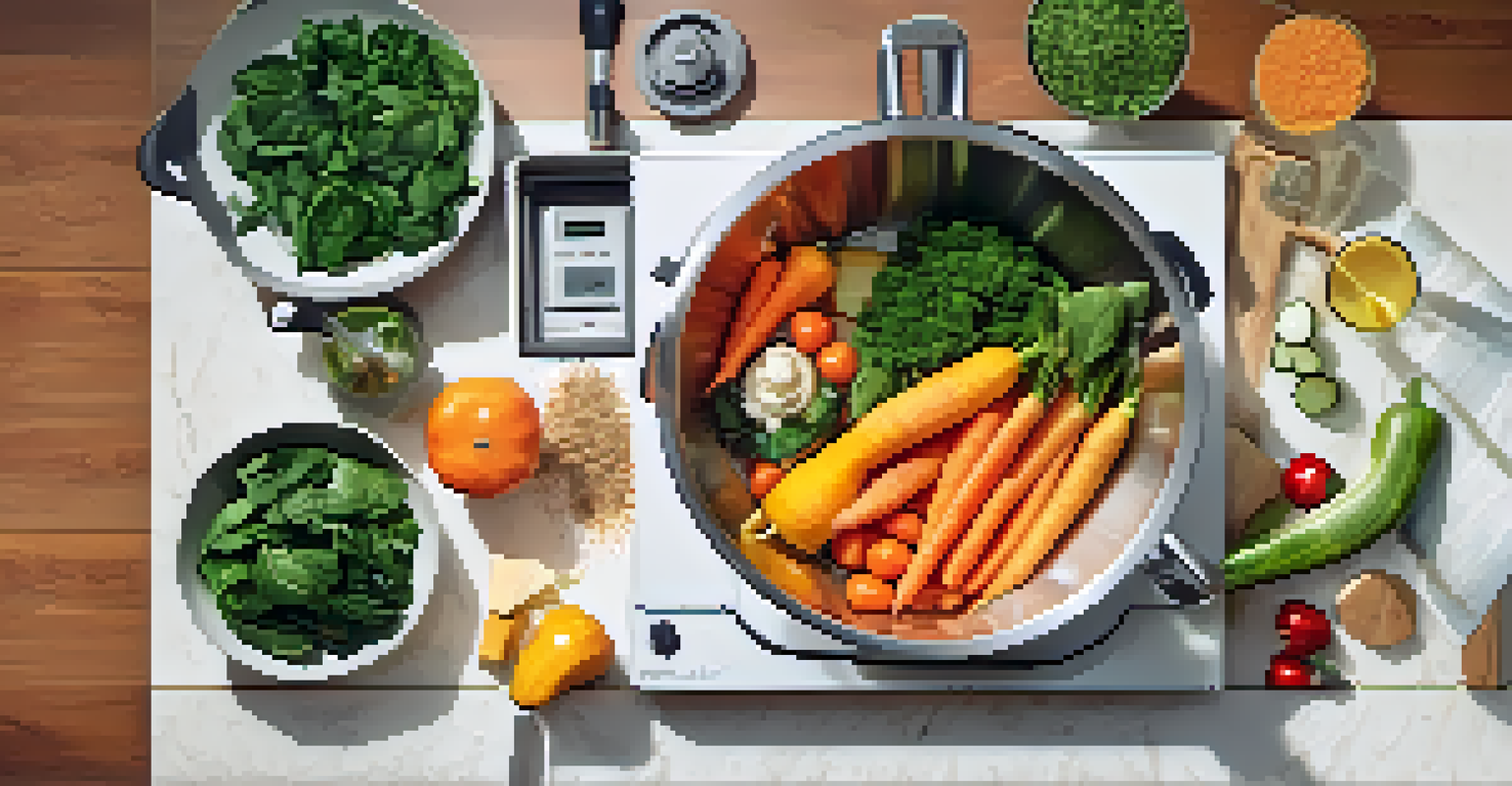The Magic of Blending: Techniques for Creamy Veggie Soups

Understanding the Basics of Creamy Veggie Soups
Creamy veggie soups are a delightful way to enjoy the rich flavors of vegetables while providing a comforting meal. At their core, these soups typically blend cooked vegetables with a liquid base, such as broth or cream, to achieve that smooth texture we all love. This process not only enhances the flavor but also allows you to pack in nutrients without compromising on taste.
Soup is a lot like a family. Each ingredient enhances the other; if you stir it up, you can create something beautiful.
The beauty of creamy soups lies in their versatility. You can use nearly any vegetable, from classic choices like carrots and potatoes to more adventurous ones like butternut squash or cauliflower. Each vegetable brings its own unique flavor profile, allowing you to create a soup that suits your palate or mood.
Additionally, creamy soups are perfect for meal prep. They can be made in large batches, stored in the fridge, and reheated as needed, making them an ideal option for busy weeks. Plus, they freeze well, so you can enjoy the magic of blending whenever you like!
Choosing the Right Vegetables for Blending
Selecting the right vegetables is crucial for creating a well-balanced creamy soup. Some vegetables, like potatoes and carrots, lend themselves beautifully to blending, adding both creaminess and sweetness. Others, like spinach or broccoli, can provide earthy flavors and vibrant colors that elevate your soup's presentation.

It's also beneficial to consider the seasonality of vegetables. Using fresh, in-season produce not only enhances the taste but can also be more economical. For example, a summer zucchini soup can be refreshing, while a hearty root vegetable blend in the winter warms you right up.
Versatile Veggie Soup Options
Creamy veggie soups can be made with a variety of vegetables, allowing for endless flavor combinations and seasonal creativity.
Don’t shy away from mixing various textures and flavors! Combining starchy vegetables like sweet potatoes with leafy greens creates a delightful balance, while adding herbs and spices can further enhance the depth of flavor. Experimenting with different combinations can lead to delightful surprises and new favorites.
Preparing Your Vegetables for Maximum Flavor
Before blending, the way you prepare your vegetables can significantly impact the flavor of your soup. Roasting vegetables like garlic, onions, or carrots can caramelize their natural sugars, resulting in a deeper, richer taste. Simply toss them in olive oil, season, and roast until tender and slightly browned.
Cooking is like love. It should be entered into with abandon or not at all.
Alternatively, sautéing your vegetables in a pot before adding liquid can also create a flavorful base. This method is particularly effective for onions and garlic, which release their essential oils and enhance the overall aroma of the soup. Don't rush this step; allowing the vegetables to soften and become aromatic is key.
Lastly, remember to season as you go. Adding herbs, salt, and pepper during the cooking process, rather than only at the end, allows the flavors to meld beautifully. This technique ensures that every spoonful of your creamy soup is packed with flavor.
The Power of Blending Techniques
Blending techniques can vary depending on the equipment available, but each method can yield delicious results. A high-speed blender often provides the smoothest texture, effectively breaking down even fibrous vegetables. If you're aiming for a velvety soup, investing in a good blender can be worthwhile.
For those without a high-speed blender, an immersion blender is a fantastic alternative. This handy tool allows you to blend soups directly in the pot, saving on dishes and making cleanup easier. Just be cautious to avoid splattering hot soup everywhere!
Preparation Enhances Flavor
How you prepare your vegetables, such as roasting or sautéing, significantly impacts the depth of flavor in your creamy soup.
If you're looking for a chunkier texture, consider blending only part of the soup and leaving the rest whole. This technique adds a delightful contrast, combining the creaminess of blended ingredients with the rustic feel of whole vegetables, making every bite interesting.
Enhancing Flavor with Broths and Creams
The liquid base of your soup, whether it be broth, stock, or cream, plays a pivotal role in the final flavor. Using homemade vegetable or chicken broth can elevate your soup to new heights, infusing it with a rich, savory depth. If you’re short on time, store-bought options can still be a convenient and tasty alternative.
For those looking to keep things lighter, vegetable broth is an excellent choice, offering a clean, fresh taste that complements a variety of vegetables. Alternatively, adding a splash of coconut milk or cream can create a lush, indulgent texture without overwhelming the vegetable flavors.
Don’t forget about the power of acidity! A squeeze of lemon juice or a dash of vinegar can brighten up your soup, cutting through the creaminess and enhancing the overall flavor. Just a little can make a world of difference, so taste as you go!
Garnishing Your Creamy Veggie Soup
Presentation is key when serving creamy veggie soups, and garnishing can elevate the dish from simple to stunning. A drizzle of olive oil or a dollop of crème fraîche adds not only visual appeal but also a rich finish to each bowl. Consider using fresh herbs like parsley or chives for a pop of color and a burst of freshness.
To add texture, think about incorporating crunchy toppings such as toasted seeds or croutons. These elements provide a delightful contrast to the smooth soup and make each bite more exciting. Plus, they can contribute additional nutrients and flavor.
Garnishing Elevates Presentation
Thoughtful garnishing with herbs, oils, or crunchy toppings can transform your creamy veggie soup into a visually stunning and flavorful dish.
Remember that garnishing is a chance to show off your creativity! Whether you’re using edible flowers for a special occasion or a sprinkle of paprika for a hint of heat, have fun with it. Your soup should be as pleasing to the eyes as it is to the palate.
Storing and Reheating Your Soups Safely
Properly storing your creamy veggie soups is essential for maintaining freshness and flavor. Once cooled, transfer the soup to airtight containers and store them in the fridge for up to a week or freeze for longer storage. Just be sure to leave some space in the container, as liquids expand when frozen.
When reheating, it's best to do so gradually on the stove over low heat. This gentle approach helps preserve the creamy texture and prevents the soup from separating or scorching. If the soup appears too thick after refrigeration, simply add a splash of broth or water to reach your desired consistency.

Always remember to taste and adjust the seasoning after reheating, as flavors can mellow over time. Whether you’re enjoying leftovers or sharing with friends, a little extra seasoning can bring your soup back to life, making it as delightful as the first time around.